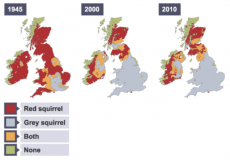

GCSE BIOLOGY REVISION: ECOLOGY
Please note: Text in bold is what the AQA GCSE biology specification requires an understanding of.
Students should be able to explain how a change in a biotic factor might affect a given community given appropriate data or context.
Biotic (living) factors which can affect a community are:
• availability of food
• new predators arriving
• new pathogens
• one species outcompeting another so the numbers are no longer sufficient to breed.
In the previous article, we discussed what biotic factors are and how food availability affects a community.
New predator arrival can have devastating effects on ecosystems. They can interrupt predator prey relationships, food availability, and shelter availability. If they come, better adapted to an environment, and better competitors, they have a higher chance of survival and thus will outcompete other species. For exam help, you could maybe research an incidence where this has occurred for a better understanding.
Along with new animal arrival, organisms that inhabit new ecosystems often bring new pathogens. For example, when the Europeans first colonised North America, they brought over the influenza virus. As the Americans had not faced this pathogen before, they had not developed immunity for the disease. Various other pathogens were brought over, some of which led to many being killed. Pathogens can be introduced on purpose. In bioterrorism, lethal pathogens have been used as a weapon in mass killing.
An example:
The effect of biotic factors on organisms
Red squirrels are native to Great Britain. They weigh around 300 grams, and about half the mass of the larger grey squirrel. The red squirrel species was introduced around a hundred years ago from America by wealthy land owners who wanted a fashionable addition to their forests.
The larger grey squirrel has provided competition for the native red squirrel, which has resulted in a lack of food for the species. Organisations like the Red Squirrel Support Trust have sampled the numbers of both squirrel types over time. Their results are shown below.
Source: BBC bitesize. Picture shows the squirrel distribution from 1945-2010
Students should be able to explain how organisms are adapted to live in their natural environment, given appropriate information.
For this point in the specification, you would have studied a few case study examples of how organisms are adapted. You will not be expected to know the ins and outs of every animal. If they give you a question on an animal you are not familiar with, the appropriate information should be there for you to interpret and draw conclusions from. They may give you a picture of the animal, in which case you may pick out features you have studied in previous case studies and you should be able to recognise how this makes them well adapted. It is important to remember what type of environment the animal is in. You should be pointing out features that make it useful to survival. For example, pointing out that an ‘animal has fur which keeps it warm’ for an animal that lives in a hot rainforest is not going to get you the marks. The temperature is warm already, the feature does not make them better adapted to the environment. However, if the organism is in the desert, that warm fur will be useful for nights where the desert gets very cold.
image-https://www.bbc.com/bitesize/guides/z9pd6yc/revision/5

0 Comment:
Be the first one to comment on this article.